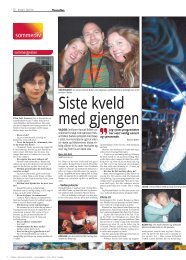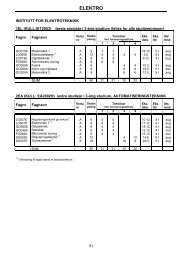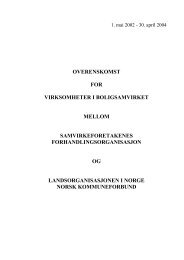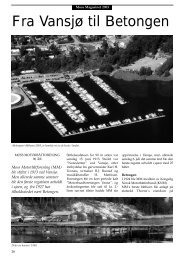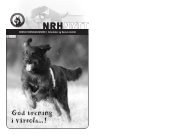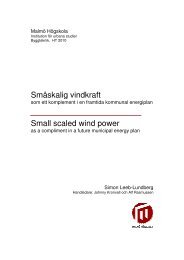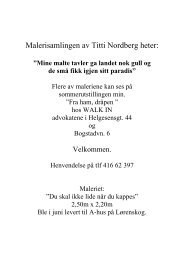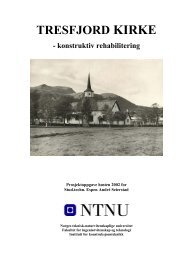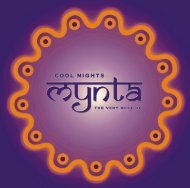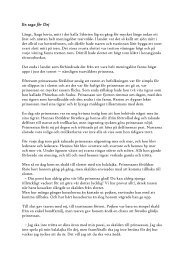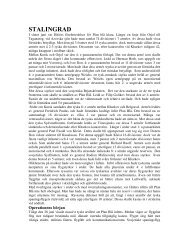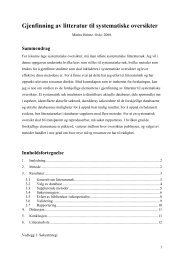Create successful ePaper yourself
Turn your PDF publications into a flip-book with our unique Google optimized e-Paper software.
<strong>Basic</strong> <strong>Norwegian</strong> <strong>grammar</strong> <strong>stuff</strong> 2<br />
NOUNS<br />
Nouns are special in <strong>Norwegian</strong> in that they are gender based, i.e. all nouns have one of three genders; masculine,<br />
feminine, neuter – and then they have a plural form, irrespective of gender. However, most feminine nouns can<br />
also be treated as a masculine noun (There are regional variations).<br />
en stol (a chair) masculine<br />
et hus (a house) neuter<br />
ei seng (a bed) feminine<br />
This means that the nouns must be graded in their respective ways. <strong>Norwegian</strong> nouns are graded into four<br />
(usually) distinctive forms, as opposed to only two in English, by incorporating the “the” (the definite article) into<br />
the noun. e.g.<br />
MASCULINE NOUNS<br />
en stol stolen stoler stolene<br />
a chair the chair chairs the chairs<br />
single indefinite single definite plural indefinite plural definite<br />
So we can see the pattern of a masculine noun clearer, here it is again:<br />
en Q Qen Qer Qene<br />
House, a neuter noun:<br />
NEUTER NOUNS<br />
et hus huset hus husene<br />
a house the house houses the houses<br />
single indefinite single definite plural indefinite plural definite<br />
et w wet w wene<br />
Note that in the plural indefinite (the third word above) there is nothing added, this is what one-syllable neuter<br />
nouns look like. [We can call this Neuter 1] Thus, three houses” will be: tre hus
Neuter nouns with two or more syllables behave like the example below [which we can call neuter 2]:<br />
et maleri maleriet malerier maleriene<br />
a painting the painting paintings the paintings<br />
single indefinite single definite plural indefinite plural definite<br />
et et er ene<br />
As you can see, it behaves just like the masculine nouns in the plural.<br />
FEMININE NOUNS<br />
ei seng senga senger sengene<br />
a bed the bed beds the beds<br />
ei L La Ler Lene<br />
Many feminine nouns that end In -e lose the -e and get an -a in the definite, e.g. ei lampe - lampa.<br />
Feminine nouns are exactly the same in plural as the masculine ones. Rather confusingly for the foreign learner,<br />
<strong>Norwegian</strong> nouns can have different genders according to where you live (or what social class you belong to). For<br />
example, some people would say “sengen” [treating ‘bed’ as a masculine noun] instead of “senga”, [a feminine<br />
noun] and some consider the former to be more conservative, but it is also the case that in Bergen there are only<br />
two genders of nouns (!), masculine and neuter, so any noun that might be feminine elsewhere is used as a<br />
masculine in Bergen. (This works fine if you’re <strong>Norwegian</strong>, but when you are trying to learn these nouns as a<br />
beginner...!)<br />
En gutt (a boy)<br />
What would the 4 different versions of the following nouns be:<br />
Remember that there are two kinds of neuter nouns<br />
En radio (a radio)<br />
En datamaskin (a computer)<br />
En penn (a pen)<br />
There are a number of irregular nouns too:<br />
Et kapittel (a chapter)<br />
Et modem (a modem)<br />
Et fall (a fall)<br />
Et fly (an aeroplane)<br />
En bok boken bøker bøkene<br />
En bror broren brødre brødrene<br />
En far faren fedre fedrene<br />
En mor moren mødre mødrene<br />
…<br />
Ei dame (a lady)<br />
Ei sti (a path)<br />
Ei dør (a door)




